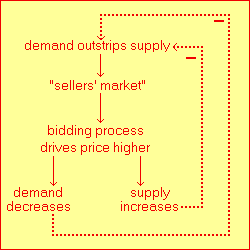| This shortage—that is, the excess of demand relative to supply—creates a temporary "sellers' market." Some buyers are willing to pay beyond the prevailing per-unit price, because the units they receive have more marginal utility to them than that price. Sellers, meanwhile, maximize their utility by dealing with these higher-bidding buyers. The bidding process thus generates an increase in the prevailing market price. As the market price is driven upward, demand decreases and supply increases until the equilibrium point is reached.
The negative-feedback loops just described are represented in the diagram at right, which illustrates a diagrammatic technique to be used extensively in the final section of this course. The solid arrows indicate positive causal influences. The dotted arrows, accompanied by minus signs, indicate how the increase in demand and decrease in supply operate to reverse the initial "demand outstrips supply" condition ( ). If the process is unclear, the student may find it helpful to trace its steps mentally one by one. ). If the process is unclear, the student may find it helpful to trace its steps mentally one by one.  |
|
 |
![]() ).
).![]()
